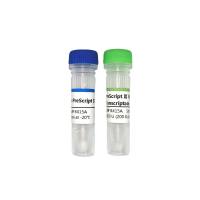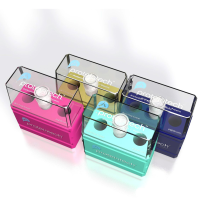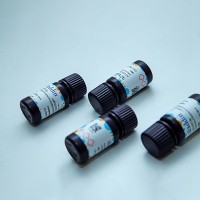Reverse SAGE (rSAGE)
互联网
Jian Yu ( Email: jianyu@jhmi.edu)
Last edited on May 1, 2000
Overview
This protocol was developed in Kinzler/Vogelstein laboratories to isolate cDNA fragments corresponding to novel SAGE tags that do not match EST databases using a PCR based method. This technique was employed in publications by Polyak et al.Nature.1997 18;389(6648):300-5 and by Yu et al. PNAS 1999 96(25):14517-14522.Using the polyA+ RNA prepared for the SAGE Library that has the most tags of interest,double stranded cDNA is synthesized with a specifically designed primer. After several enzymatic manipulations much like SAGE, the 3’ends enriched cDNA fragments (primary rSAGE library) is used as template for PCR reactions to obtain sufficient quantity of DNA, so called amplified rSAGE library. Second PCR amplification is carried out with SAGE tag specific primer and a common primer M13F to obtain specific product. Sequence of PCR product is used to verify the authenticity of a given SAGE tag and to obtain additional nucleotide sequence that can be used in database search or designing primers for 5’ RACE. The purified PCR produce can be used in a variety of hybridization based applications.
You will need the SAGE protocol as reference. Many steps of rSAGE are similar, even identical to that of SAGE and many reagents are shared by these two protocols. The same careful practice should be exercised to avoid PCR product contamination as much as possible. Close attention paid to the protocol during experiments will facilitate trouble-shooting should problems arise.
rSAGE Diagram
Methods
Step 1. cDNA synthesis with modified oligodT primer BRS1
Prepare Total RNA and polyA+ (Approximately 2-5 ug is needed for good representation) as described in SAGE.
Synthesize the 1st strand cDNA with Superscript choice System for cDNA synthesis kit (GibcoBRL Cat. No. 18090019) primed with gel purified BRS1 oligo and save one tenth for electrophoresis. Follow the manufacturers’ instructions on the 2nd stand synthesis. Precipitate resulted cDNA and resuspend in 22ul LoTE and save 2 ul for
electrophoresis.
Analyze the saved 1st and 2nd cDNA product along with 1kb ladder on a 1.2% agarose gel/EtBr for 2 hours. Proceed if expected pattern is observed.
Step 2. Nla III digestion
See SAGE protocol
Step 3. Bind Biotinylated cDNA to magnetic beads
See SAGE protocol.
Step 4. Linker ligation
See SAGE protocol and below.
Only linker 2A and 2B are used in rSAGE. They are used at one fifth of that used in SAGE protocol version1.0c.
You can use the same linker you prepared for SAGE if it’s less than 3-month old.
Otherwise, linker 2A and 2B should be kinased and tested for self-ligation as described in SAGE protocol. Divide the beads into two microfuge tubes and proceed.
+ligase -ligase
2A/B (200ng/ul) 2 ul 2 ul
LoTE 28 ul 28 ul
5x ligase buffer 8 ul 8 ul
Mix beads slurry bound with cDNA gently but well, heat the tubes at 50oC for 2 minutes and leave them at room temperature for 15 minutes. Add 2ul ligase in +ligase tube and incubate both tubes at 16oC for two hours.
After ligation, wash beads 4x with 1X B+W and transfer the last wash mixture into 2 clean microfuge tubes and discard sup as usual. Proceed immediately to the next step.
Step 5. Asc I digestion to release the 3’ cDNA fragments from beads Resuspend the beads in +ligase or �ligase tubes by adding the following components.
LoTE 85 ul
10x NEB buffer 4 10 ul
100x BSA 2 ul
Asc I 2 ul
Mix contents gently and well with pipette and incubate at 37 oC for 1 hour.
After digestion, collect supernatant carefully with magnet. Extract 1X with PC8 and high-concentration ethanol precipitate (see SAGE protocol) and resuspend DNA in 25 ul LoTE. The +ligation tube is the primary rSAGE library.
Step 6. Generation of amplified rSAGE library by PCR
Make several dilutions of + and � ligase ligation product. Usually 1ul of 1/50 and 1/300 dilution is recommended for PCR. However due to frequent variations in yield, this can differ by a factor of 10 but they are good starting point.
ligation dilution 1 ul
10x PCR buffer 5 ul
DMSO 3 ul
dNTPs (10 mM) 3 ul
M13F (350 ng/ul) 1 ul
SAGE Primer 2 (350 ng/ul) 1 ul
ddH2O 36 ul
Tag 1 ul
Follow the following PCR cycling condition:
94oC 2’ 1 cycle
94 oC 45”, 57 oC 1’, 70 oC 1’ 25 cycles
70 oC 5’ 1 cycle
Analyze 10 ul PCR product on a 4-20% Novex gel along with 1kb ladder. You should see strong smear (predominantly in 100-700bp range) in all the +ligation dilutions but none of the �ligation dilutions should be visible following EB staining. The PCR product of + ligase dilutions is refereed as amplified rSAGE library.
Step 7. SAGE tag specific primer
Design the gene specific forward primer in such a way that the bold letters (14bp or 15bp if additional one bp can be determined by SAGE software.) are included plus additional 7 to 10 bases at further 5’ of linker 2A and resulted primer has a melting temperature around 60 oC (calculated as: 4 X #(G/C) + 2X # (A/T))
Step 10. Verify Tag sequence
Once complete sequence of the PCR product is obtained, it’s recommended to check whether the correct tag is present in the PCR product or it is indeed after the last CATG before PolyA signal, if possible, before further analysis.
If the presence of the tag is confirmed, the additional nucleotide sequence obtained, usually hundreds of base pair long, can help blast search considerably. If you are still unable match it to known sequence or ESTs, you might have a novel gene.(Congratulation!) The purified PCR product can be used as probe on northern blot analysis, and library screening. The additional sequence can also help you design primers for 5’ RACE to isolate full length cDNA if the mRNA is small.
Reagents
Please see SAGE protocol for solutions, Dynal beads and commonly used methods. It’s highly recommended to follow all the specifications for the reagents in SAGE protocol unless specified otherwise in rSAGE protocol.
Primers and Linkers








